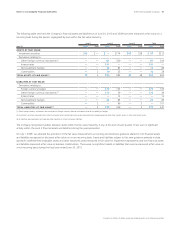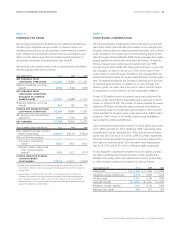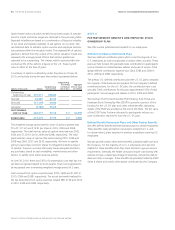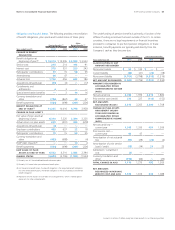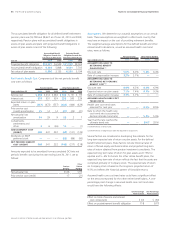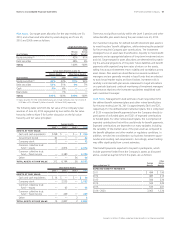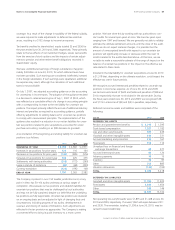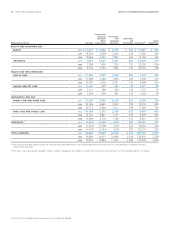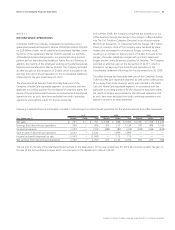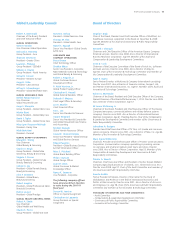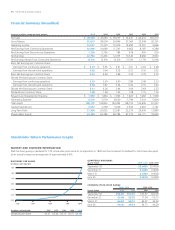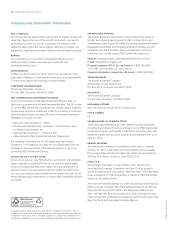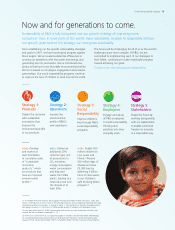Proctor and Gamble 2010 Annual Report Download - page 73
Download and view the complete annual report
Please find page 73 of the 2010 Proctor and Gamble annual report below. You can navigate through the pages in the report by either clicking on the pages listed below, or by using the keyword search tool below to find specific information within the annual report.Notes to Consolidated Financial Statements The Procter & Gamble Company 71
Amounts in millions of dollars except per share amounts or as otherwise specified.
NOTE 11
SEGMENT INFORMATION
Effective July1, 2009, the Company implemented a number of
changes to the organization structure of the Beauty GBU, which
resulted in changes to the components of its reportable segment
structure. The following discussion and segment information reflect
the organizational changes for all periods presented. We are orga-
nized under three GBUs as follows:
• The Beauty and Grooming GBU includes the Beauty and the
Grooming businesses. The Beauty business is comprised of female
beauty products (including cosmetics, deodorants, female blades
and razors, personal cleansing and skin care), hair care (including
both retail and salon professional) and prestige fragrances. The
Grooming business includes electric hair removal devices, home
appliances, male blades and razors and male personal care products
(including deodorants, face and shave products, hair care and
personal cleansing).
• The Health and Well-Being GBU includes the Health Care and the
Snacks and Pet Care businesses. The Health Care business includes
feminine care, oral care and personal health care. The Snacks and
Pet Care business includes snacks and pet food.
• The Household Care GBU includes the Fabric Care and Home Care
as well as the Baby Care and Family Care businesses. The Fabric
Care and Home Care business includes air care, batteries, dish care,
fabric care and surface care. The Baby Care and Family Care business
includes baby wipes, bath tissue, diapers, facial tissue and paper
towels.
Under U.S. GAAP, we have six reportable segments: Beauty;
Grooming; Health Care; Snacks and Pet Care; Fabric Care and Home
Care; and Baby Care and Family Care. The accounting policies of the
businesses are generally the same as those described in Note 1.
Differences between these policies and U.S. GAAP primarily reflect
income taxes, which are reflected in the businesses using applicable
blended statutory rates, and the treatment of certain unconsolidated
investees. Certain unconsolidated investees are managed as integral
parts of our business units for management reporting purposes.
Accordingly, these partially owned operations are reflected as consoli-
dated subsidiaries in segment results, with full recognition of the
individual income statement line items through before-tax earnings.
Eliminations to adjust these line items to U.S. GAAP are included in
Corporate. In determining after-tax earnings for the businesses, we
eliminate the share of earnings applicable to other ownership interests,
in a manner similar to noncontrolling interest and apply statutory tax
rates. Adjustments to arrive at our effective tax rate are also included
in Corporate.
Corporate includes certain operating and non-operating activities that
are not reflected in the operating results used internally to measure
and evaluate the businesses, as well as eliminations to adjust manage-
ment reporting principles to U.S. GAAP. Operating activities in Corporate
include the results of incidental businesses managed at the corporate
level along with the elimination of individual revenues and expenses
generated by certain unconsolidated investees discussed in the pre-
ceding paragraph over which we exert significant influence, but do
not control. Operating elements also include certain employee benefit
costs, the costs of certain restructuring-type activities to maintain a
competitive cost structure, including manufacturing and workforce
rationalization and other general Corporate items. The non-operating
elements in Corporate primarily include interest expense, divestiture
gains and interest and investing income. In addition, Corporate includes
the historical results of certain divested businesses.
Total assets for the reportable segments include those assets managed
by the reportable segment, primarily inventory and fixed assets.
Other assets, primarily including cash, accounts receivable, investment
securities and goodwill, are included in Corporate.
The Company had net sales in the U.S. of $30.0billion, $29.6billion
and $29.7billion for the years ended June30, 2010, 2009 and 2008,
respectively. Assets in the U.S. totaled $70.1billion and $71.9billion
as of June30, 2010 and 2009, respectively.
Our largest customer, Wal-Mart Stores, Inc. and its affiliates,
accounted for 16% of consolidated net sales in 2010, 2009 and 2008.


